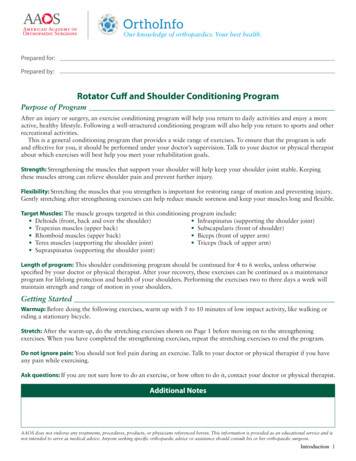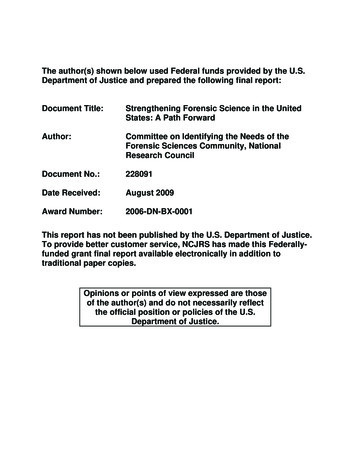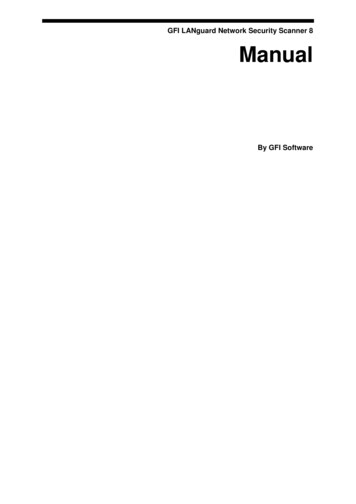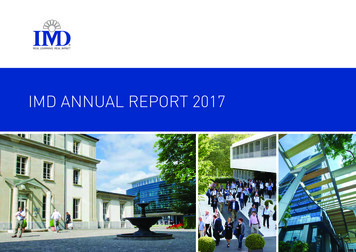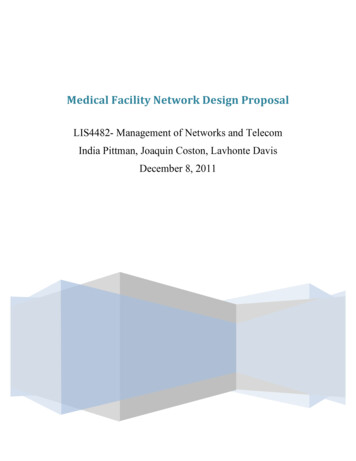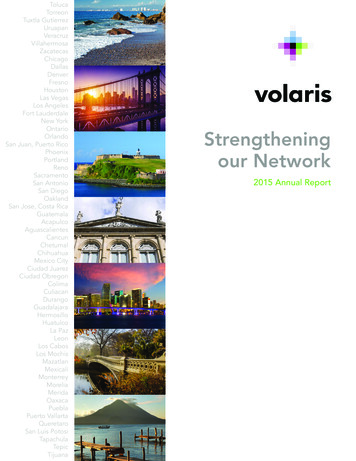
Transcription
TolucaTorreonTuxtla goDallasDenverFresnoHoustonLas VegasLos AngelesFort LauderdaleNew YorkOntarioOrlandoSan Juan, Puerto RicoPhoenixPortlandRenoSacramentoSan AntonioSan DiegoOaklandSan Jose, Costa hihuahuaMexico CityCiudad JuarezCiudad uatulcoLa PazLeonLos CabosLos PueblaPuerto VallartaQueretaroSan Luis PotosiTapachulaTepicTijuanaStrengtheningour Network2015 Annual Report
Volaris2015 Annual Report1Comments and Analysisfrom the Board on Operating Resultsand Financial SituationDescription of Our Principal Line ItemsOperating RevenuesOperating and Financial Review and ProspectsOperating ResultsYou should read the following discussion of our financial condition and results of operationsin conjunction with our consolidated financial statements and the notes thereto includedelsewhere in this annual report. The following discussion contains forward–lookingstatements that reflect our plans, estimates and beliefs. Our actual results could differmaterially from those discussed in the forward–looking statements. Factors that couldcause or contribute to these differences include those discussed below and elsewhere inthis annual report, particularly in “Risk Factors.”Passenger Revenue. We derive our operatingrevenues primarily from transporting passengerson our aircraft. Approximately 78% of our totaloperating revenues were derived from passengerfares in 2015. Passenger revenues are based uponour capacity, load factor and the average ticketrevenue per booked passenger. Our capacity ismeasured in terms of ASMs, which represents thenumber of seats we make available on our aircraftmultiplied by the number of miles the seats areflown. Load factor, or the percentage of our capacity that is actually used by paying customers,is calculated by dividing RPMs by ASMs. The average ticket revenue per booked passenger represents the total passenger revenue divided bybooked passengers.Non–ticket Revenue. We derived approximately 22% of our total operating revenues in 2015from non–ticket revenue. The most significantnon–ticket revenues include revenues generated from (i) air travel–related services (ii) revenuesfrom non–air–travel related services and (iii) cargoservices.Air travel–related services include, but are not limited to, fees charged for excess baggage, bookingsthrough our call center or third–party agencies, advanced seat selection, itinerary changes, chartersand passenger charges for no–show tickets. Theyare recognized as revenue when the related transportation service is provided.Non–air–travel–related services include commissions charged to third parties for the sale of hotel rooms, trip insurance and rental cars. They arerecognized as revenue at the time the service isprovided. Additionally, services not directly related to air transportation include Volaris’ sale ofVClub membership and the sale of advertisingspaces to third parties. VClub membership feesare recognized as revenues over the life of themembership. Revenue from the sale of advertising spaces is recognized over the period in whichthe space is provided.Revenues from cargo services are recognizedwhen the cargo transportation is provided (upondelivery of the cargo to destination).
Volaris2015 Annual ReportThe following table shows each of the line items in our consolidated statements of operations for theperiods indicated as a percentage of our total operating revenues for that period:For the Years ended December 31,2013 2014 2015Operating revenues:Passenger1Non–ticket86% 81%78%14%22%19%Total operating revenues 100% 100% 100%Other operating income(1%)Fuel39% 38%26%Aircraft and engine rent expense17%18%19%Landing, take–off and navigation expenses15%15%14%Salaries and benefits12%11%10%Sales, marketing and distribution expenses5%6%6%Maintenance expenses4%5%5%Other operating expenses4%3%4%Depreciation and amortization2%2%3%Total operating expenses, net0%(1%)98% 99% 86%Operating income2%1%14%Finance income0%0%0%Finance cost(1%)0%0%Exchange gain, net1%3%5%Income before income tax2%5%19%Income tax expense0%0%(6%)Net income2% 4% 14%(1) NTD: Volaris as a reminder the SEC wants you to open up this line item. This should be done in the notes to the financialstatements.Revenues from our international operations represented 26.0%, 27.2% and 30.8% of our totalrevenues in 2013, 2014 and 2015, respectively,and revenues from our domestic operations represented 74.0%, 72.8% and 69.2% of our totalrevenues in 2013, 2014 and 2015, respectively.Revenue Recognition. Revenues from the airtransportation of passengers and commissionsfrom ground transportation services are recognized at the earlier of when the service is provided or when the non–refundable ticket expires atthe date of the scheduled travel. Ticket sales forfuture flights are initially recognized as liabilitiesunder the caption unearned transportation revenue and, upon provision of the correspondingtransportation service or expiration of the ticket,the earned revenue is credited to operations asrevenues and the liability account is reduced bythe same amount. All of our tickets are non–refundable, and subject to change upon the payment of a fee. Additionally, we do not operate afrequent flier program. Our most significant non–ticket revenues include revenues generated from(i) air travel–related services, (ii) non–air–travel related services, and (iii) cargo services:Air travel–related services include, but are not limited to, fees charged for excess baggage, bookingsthrough our call center or third–party agencies, advanced seat selection, itinerary changes, chartersand passenger charges for no–show tickets. Theyare recognized as revenue when the related transportation service is provided.Non–air–travel–related services include commissions charged to third parties for the sale of hotel rooms, trip insurance and rental cars. They arerecognized as revenue at the time the service is2provided. Additionally, services not directly related to air transportation include Volaris’ sale ofVClub membership and the sale of advertisingspaces to third parties. VClub membership feesare recognized as revenues over the life of themembership. Revenue from the sale of advertising spaces is recognized over the period in whichthe space is provided. Revenue from cargo services are recognized when the cargo transportation is provided (upon delivery of the cargo todestination).We are also required to collect certain taxes andfees from customers on behalf of governmentagencies and airports and remit these back tothe applicable governmental entity or airport ona periodic basis. These taxes and fees include value added tax, federal transportation taxes, federal security charges, airport passenger facilitycharges, and foreign arrival and departure taxes.These items are collected from customers at thetime they purchase their tickets, but are not included in passenger revenue. We record a liabilityupon collection from the customer and dischargethe liability when payments are remitted to theapplicable governmental entity or airport.Operating Expenses, netOur operating expenses consist of the followingline items.Other Operating Income. Other operating income primarily includes the gains from sale andlease back operations of our aircraft and engines.Fuel. Fuel expense is our single largest operating expense. It includes the cost of fuel, relatedtaxes, fueling into–plane fees and transportation
Volaris2015 Annual Reportfees. It also includes realized gains and losses thatarise from any fuel price derivative activity qualifying for hedge accounting.Aircraft and Engine Rent Expense. Aircraft rentexpense consists of monthly lease rents for our56 aircraft and six spare engines, as of December31, 2015, under the terms of the related operating leases and is recognized on a straight line basis. Aircraft rent expense also includes gains andlosses related to our interest rate swap contractsthat qualify for hedge accounting. Additionally, ifwe determine that we will probably not recoverpartially or completely the maintenance depositswe pay to the lessor as maintenance deposits, werecord these amounts in the results of operationsas additional aircraft rent (supplemental and contingent rent) from the time we make the determination over the remaining term of the lease.Salaries and Benefits. Salaries and benefits expense includes the salaries, hourly wages, employee health insurance coverage and variablecompensation that are provided to employeesfor their services, as well as the related expensesassociated with employee benefit plans and employer payroll taxes.Landing, Take–off and Navigation Expenses.Landing, take–off and navigation expenses include airport fees, handling charges, and other rents, which are fixed and variable facilities’expenses, such as the fees charged by airportsfor the use or lease of airport facilities, as wellas costs associated with ground handling services that we outsource at certain airports. Thisexpense also includes route charges, which arethe costs of using a country’s or territory’s air-space, and are levied depending on the distance flown over such airspace.Sales, Marketing and Distribution Expenses.Sales, marketing and distribution expensesconsist of advertising and promotional expensesdirectly related to our services, including the costof web support, our outsourced call center, travelagent commissions, and credit card discount feesthat are associated with the sale of tickets andother products and services.Depreciation and Amortization. Depreciation andamortization expense includes the depreciationof all rotable spare parts, furniture and equipmentwe own and leasehold improvements to flightequipment. It also includes the amortization ofmajor maintenance expenses we defer underthe deferral method of accounting for majormaintenance events associated with the aging ofOther Operating Expenses. Other operating expenses include (i) administrative support such astravel expenses, stationery, administrative training, monthly rent paid for our headquarters’ facility, professional fees and all other administrativeand operational overhead expenses; (ii) costsfor technological support, communication systems, cell phones, and internal and operationaltelephone lines; (iii) premiums and all expensesrelated to the aviation insurance policy (hull andliability); (iv) outsourced ground services and thecost of snacks and beverages that we serve onboard to our passengers; and (v) rent expenseassociated with the lease of our maintenancewarehouse and hangar.our fleet and recognize over the shorter periodof the next major maintenance event or theremaining lease term.A common measure of per unit costs in the airlineindustry is cost per available seat mile (CASM).The following table shows the breakdown ofCASM for the periods indicated:For the years ended December 31,Maintenance Expenses. Maintenance expensesinclude all parts, materials, repairs and fees forrepairs performed by third–party vendors directlyrequired to maintain our fleet. It excludes thedirect labor cost of our own mechanics, which isincluded under salaries and benefits and includesonly routine and ordinary maintenance expenses.Major maintenance expenses are capitalizedand subsequently amortized as described in“—Depreciation and Amortization—” below.3201320142015 2015(In U.S. cents)(In Ps.cents)(1)Other operating income(1.0)(0.2)Fuel46.745.3 33.61.9Aircraft and engine rent expense20.121.425.11.5Landing, take–off and navigation expenses17.617.518.51.1Salaries and benefits14.313.313.50.8Sales, marketing and distribution expenses6.56.97.70.4Maintenance expenses5.25.66.20.4Other operating expenses4.24.15.00.3Depreciation and amortization2.82.93.30.2Total operating expenses, net(1.4)116.4 116.9 111.5(0.1)6.5(1) Peso amounts were converted to U.S. dollars solely for the convenience of the reader at the rate of Ps.17.2065 per U.S. 1.00 as the rate for the payment of obligations denominated in foreign currency payable in Mexico in effect on December31, 2015. Such conversions should not be construed as a representation that the peso amounts actually represent such U.S.dollar amounts or could be converted into U.S. dollars at the rate indicated, or at all.
Volaris2015 Annual ReportTrends and Uncertainties Affecting OurBusinessWe believe our operating and business performance is driven by various factors that affectairlines and their markets, trends affecting thebroader travel industry, and trends affecting thespecific markets and customer base that we target. The following key factors may affect our future performance.Economic Conditions in Mexico. Mexico’s GDPis expected to grow by 3% to 4% per year forthe next ten years according to the MexicanCentral Bank, which is 1 basis point to 2 basispoints above the expected annual growth forthe United States during the same period asreported by the U.S. Federal Reserve. Mexico’sprojected GDP growth is expected to result inthe number of middle–income homes continuingtheir growth trend, having already grown from 5.1million in 1992 to 15.8 million in 2008. Regardingpopulation dynamics as of 2010, around 39% ofthe Mexican population was under 20 years ofage, which benefits us by providing a strong baseof potential customer growth. Inflation in Mexicoduring 2015 was 2.13% according to the INEGI.As of December 31, 2015, international reserveswere at U.S. 1.77 billion.Competition. The airline industry is highly competitive. The principal competitive factors in theairline industry are fare pricing, total price, flightschedules, aircraft type, passenger amenities andrelated services, number of routes served from acity, customer service, safety record and reputation, code–sharing relationships and frequent flier programs and redemption opportunities. Ourcurrent and potential competitors include tradi-tional network airlines, low–cost carriers, regional airlines and new entrant airlines. We typicallycompete in markets served by legacy carriers andother low–cost carriers, and, to a lesser extent, regional airlines. Some of our current or future competitors may have greater liquidity and access tocapital and may serve more routes than we do.Our principal competitive advantages are our lowbase fares and our focus on VFR travelers, leisuretravelers and cost–conscious business people.These low base fares are facilitated by our lowCASM, which at Ps.111.5 cents (U.S. 6.5 cents)we believe was the lowest CASM in Latin America in 2015, compared to Avianca at U.S. 15.0cents, Copa at U.S. 9.2 cents, Gol at U.S. 9.7cents, Grupo Aeroméxico at U.S. 10.2 cents andLATAM at U.S. 11.5 cents. We also have lowercosts than our publicly traded target market competitors in the United States, including Alaska Airat U.S. 10.8 cents, American at U.S. 12.9 cents,Delta at U.S. 13.3 cents, JetBlue at U.S. 10.6cents and Soutwest Airlines at U.S. 11.2 centsand United at U.S. 13.1 cents.Our principal competitors for the domestic market are Grupo Aeroméxico, Interjet and VivaAerobus, Interjet and VivaAerobus are low–costcarriers in Mexico. In 2015, the Mexican low–costcarriers (including us) combined had 61.1% of thedomestic market based on passenger flight segments. We had 24.76% of the domestic marketwhich placed us second, according to the DGAC.We also face domestic competition from groundtransportation alternatives, primarily long–distance bus companies. There are limited passenger rail services in Mexico. There is a large busindustry in Mexico, with total passenger seg-ments of approximately 2.9 billion in 2015, ofwhich approximately 79 million were executiveand luxury passenger segments, according tothe Mexican Authority of Ground Transportation(Dirección General de Autotransporte Federal)and which could include both long– and short–distance travel. We set certain of our promotional fares at prices lower than bus fares for similarroutes in order to stimulate demand for air travelamong passengers who in the past have traveledlong distances primarily by bus. We believe asmall shift of bus passengers to air travel woulddramatically increase the number of airline passengers and bring the air trips per capita figuresin Mexico closer to those of other countries in theAmericas.4ening economic conditions, fare initiatives, fluctuations in fuel prices, labor actions, weather andother factors have resulted in significant fluctuations in our revenues and results of operations inthe past. Particularly, in 2008, the demand for airtransportation services was significantly adverselyaffected by both the severe economic recessionand the record high fuel prices. We believe, however, that demand for business travel historicallyhas been more sensitive to economic pressuresthan demand for low–price leisure and VFR travel,which are the primary markets we serve.Our principal competitors for the internationalroutes between Mexico and the United States areGrupo Aeroméxico, Alaska Air, Delta and United.We have grown rapidly in the international market since we started international operations in2009, reaching 34.3% market share on the routesthat we operate and 6.3% market share considering all routes between Mexico and the UnitedStates in 2015, according to the DGAC.Fuel. Fuel costs represent the single largest operating expense for most airlines, including ours,accounting for 40%, 39% and 30% of our total operating expenses for 2013, 2014 and 2015. Fuelavailability and pricing are also subject to refiningcapacity, periods of market surplus and shortage,and demand for heating oil, gasoline and otherpetroleum products, as well as economic, socialand political factors and other events occurringthroughout the world, which we can neither control nor accurately predict. We source a significantportion of our fuel from refining sources locatedin Mexico.Seasonality and Volatility. Our results of operations for any interim period are not necessarilyindicative of those for the entire year because ourbusiness is subject to seasonal fluctuations. Wegenerally expect demand to be greater duringthe summer in the northern hemisphere, in December and around Easter, which can fall either inthe first or second quarter, compared to the restof the year. Our business is also volatile and highly affected by economic cycles and trends. Consumer confidence and discretionary spending,fear of terrorism or war, health outbreaks, weak-During the years ended December 31, 2013,2014 and 2015 we entered into US Gulf Coast Jetfuel 54 swap contracts to hedge approximately11%, 20% and 5% of our fuel consumption, respectively. These instruments were formally designated and qualified for hedge accounting andaccordingly, the effective portion is allocatedwithin other comprehensive income, while the effects of transforming into a fixed jet fuel pricesby these hedges are presented as part of jet fuelcosts when recognized in the consolidated statements of operations. Our fuel hedging practices
Volaris2015 Annual Reportare dependent upon many factors, including ourassessment of market conditions for fuel, our access to the capital necessary to support marginrequirements under swap agreements and thepricing of hedges and other derivative productsin the market.and the U.S. dollar. As a result of the significantdepreciation and appreciation of the peso againstthe U.S. dollar in the last three years, we recordeda foreign exchange gain, net of Ps.66.4 million in2013, Ps.448.7 million in 2014 and Ps.966.6 million in 2015.Additionally, during the year ended December31, 2015, we also entered into US Gulf Coast Jetfuel 54 Asian call options designated to hedgeapproximately 55% and 23% of our 2016 and2017 projected fuel consumption, respectively.Maintenance Expenses. We are required to conduct varying levels of aircraft and e
Non–air–travel–related services include commis-sions charged to third parties for the sale of ho-tel rooms, trip insurance and rental cars. They are recognized as revenue at the time the service is provided. Additionally, services not directly re-lated to air
